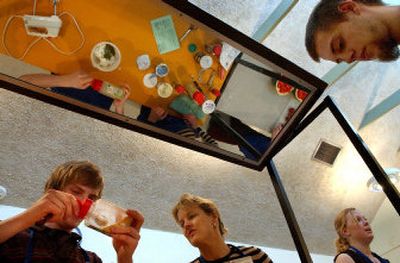Inexpensive, healthy, tasty

Every month, Alyson Mai ventures out to Barker High School to instruct a handful of students on making a healthy meal on a blue-collar budget.
The students blurt out a top-dollar request.
“Steak. No, shrimp. No, shrimp and steak.”
No, cautioned Mai, a Washington State University dietitian. Theirs is a pot-roast, not porterhouse, palate. Their fare isn’t Beverly’s, it’s bistro, or more specifically Barker Bistro, Central Valley School District’s name for this once-a-month class on food and finances. Participating students are selected by recommendation. They prepare a meal for roughly 20 people at less than $4 a plate.
The U.S. Department of Agriculture pays for the dinner, in hopes that the class will help stem the wave of child health problems associated with obesity. To qualify, schools must have at least half their students receiving free or reduced-price lunches because of low-family income. Mai runs the bistro as a coordinator for a program known as Food $ense, which provides a grab bag of healthy eating programs for low-income families.
Barker High School fits the mold of what the USDA has in mind: A high number of students living independently, raising children of their own or living in low-income families. Mai and others say the child health problem crosses social and racial lines and would benefit everyone if funding was available.
Barker students really aren’t any more prone to health problems than their counterparts in other schools. America’s youth as a whole are not as healthy as they once were. The number of overweight children has doubled since the 1970s. Federal officials sounded the alarm four years ago after the National Institutes of Health reported that one in five children in the United States was overweight.
Type II diabetes, most often associated with overweight adults, is found in the nation’s obese youth. Instances of high blood pressure and high cholesterol, both risk factors for heart disease, are increasing in children. And overweight children have a 70 percent chance of not shedding that baby fat as they grow into adulthood.
“We’re the first generation (of parents) that our children might not outlive us,” said Karin Gilchrist, a WSU dietitian working in Spokane’s public schools. “When I was a kid there were no cases of Type II diabetes at school.”
At Barker School, the bistro tackles eating habits on several fronts.
Traditional family recipes, like one for cheesy potatoes brought in by student Phil Butcher, are modified to make them healthier. Butcher’s recipe called for processed cheese slices and garlic salt.
Mai opted for grated cheese because it’s less processed and garlic powder instead of high-sodium garlic salt.
Students also are required to spread out tablecloths and properly set plates and silverware. It’s a practice the National Institutes of Health encourages because families who eat at a set table, as opposed to on a couch in front of the TV, tend to eat slowly and enjoy their food, which in theory leads to eating less.
“How do we do this?” asked freshman Ashley Whiteaker, putting a placemat-size cloth on a table. The 15-year-old lives with her older sister, and most of their meals are home-cooked but eaten in the living room.
“My mom and I used to set the table on holidays,” she said, but that hasn’t happened in a while.
In almost every class that Mai and Gilchrist teach, there’s a lesson on economizing. Mai works with young mothers on the lower cost and higher nutrition of home-blended baby food, and how to feed the rest of their family affordably and healthfully.
Gilchrist teaches students as early as fourth grade the benefits of cooking at home and subtly suggests where food stamps might come in handy. She also converts written recipes to picture recipes for students who cannot read.
Back at the bistro, lunch is a huge success with food to feed 23 people and leftovers. There’s ham, fruit salad, vegetables and Butcher’s cheesy potatoes. There’s even strawberry parfait in the refrigerator.
“Anyone want to guess how much this would cost in a restaurant?” asked Mai, to which the students guess $17.95. “How about at home, per plate?”
One dinner guest suggests the dinner, per person, cost $7.95, just about the same cost for a super-sized fast-food meal bought on the fly.
“Actually,” said Mai. “It’s between $2 and $3.”